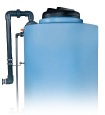Poly Processing has three manufacturing plants in the United States. In each facility, we use a multi-step quality control process that meets and/or exceeds industry standards, including ASTM D-1998. The ASTM D-1998 standard is designed to give end users a margin of safety and peace of mind. It’s a voluntary standard, and not all tank manufacturers follow it.
Topics:
Value Added
With over 50 years of experience in creating tanks, fittings, accessories and other materials that ensure your chemical storage solution is safe and tailored to the chemical you are storing, we understand the importance of using the right products for your chemical. We’ve learned how the most popularly stored chemicals, like Sulfuric Acid, Sodium Hypochlorite and Hydrochloric Acid, react to improper storage systems. One part of those tank systems that is crucial is a tank’s gaskets. The tank’s gaskets act as a mechanical seal with a particular fitting to prevent leaks or spills. It is very important to make sure the gaskets and bolts used on your storage tanks are in compliance with what is needed to protect your tank fittings from corrosion caused by reactive chemicals.
Topics:
Fittings and Accessories
Sodium hydroxide, also known as caustic soda or liquid lye, is commonly used to adjust pH levels in water and wastewater and can easily change hard water to a much closer approximation to neutral when injected into the water treatment system. Caustic soda can act as a corrosion inhibitor without the uneven distribution of calcium carbonate. Caustic soda is also used in the manufacturing of chemicals, rayon, cellophane, paper, detergents, soaps, and a variety of other products.
Topics:
Chemicals
Phosphoric acid is one of the top ten chemicals used in the United States. Phosphates have many uses in the treatment of drinking water. Food grade phosphoric acid is common in the food industry, and it’s even used in pharmaceuticals, detergents, and textile pigments.
Topics:
Chemicals
Poly Processing is the leader in innovative chemical storage solutions, but our customers deserve even more. A quality product is only one important part of our service to you. We also take seriously our responsibility to equip our customers to be successful with the chemical storage solutions they purchase.
Topics:
Technology Tips
Coagulation is one of the preliminary steps in treating wastewater to make it safe for drinking. When chemicals are used, proper design and engineering of the storage tank can help ensure safety, longevity, and operational efficiency.
Topics:
Applications
Before you purchase a chemical storage tank, it’s important to know what kind of service to expect from the manufacturer — immediately and for years to come. You might have installation and startup needs, but you may also have questions about retrofitting a tank or installing new tanks. Many tank manufacturers don’t have a field service team or service department. Instead, they hire a local fix-it professional who isn’t familiar with their storage systems. Other times, you might have to find a service technician yourself. Poly Processing has our own on-site nationwide field service team that can service your PPC chemical storage tank at your facility. Let’s take a look at the types of on-site service our dedicated technicians are doing on a daily basis.
Topics:
Value Added
One of the most critical aspects of choosing and building a chemical storage tank system is tank design. Poly Processing makes this process as simple as possible for you by providing easy access to resources and several types of tank drawings.
Topics:
Technology Tips
Poly Processing has three strategically located manufacturing plants, headquartered in Monroe, Louisiana — with plants in Winchester, Virginia and French Camp, California as well. These locations give us the ability to easily transfer inventory and ship tanks to our customers throughout the United States.
Topics:
Installation and Field Service
At Poly Processing Company, we make it a top priority to ensure that you have all of the information needed to build a safe, reliable chemical storage system. That's why our complete digital product catalog is more than just a list of everything we offer. We've developed a catalog that is educational and a valuable resource for building a Poly Processing tank system that's right for your specific application. We're pleased to announce that we've updated our complete catalog with new content. The catalog includes 80 pages of chemical storage guidelines, Poly Processing Company tanks, tank accessories, custom fittings, and much more.



